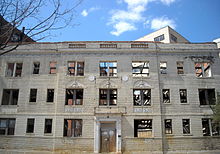
Back إعادة الاستخدام المتكيف Arabic アダプティブユース Japanese Herbestemming Dutch Adaptacja (architektura) Polish

This article is written like a personal reflection, personal essay, or argumentative essay that states a Wikipedia editor's personal feelings or presents an original argument about a topic. (February 2023) |
Adaptive reuse refers to the process of reusing an existing building for a purpose other than which it was originally built or designed for. It is also known as recycling and conversion.[1] Adaptive reuse is an effective strategy for optimizing the operational and commercial performance of built assets.[2] Adaptive reuse of buildings can be an attractive alternative to new construction in terms of sustainability and a circular economy.[3] It has prevented thousands of buildings' demolition and has allowed them to become critical components of urban regeneration.[1] Not every old building can qualify for adaptive reuse. Architects, developers, builders and entrepreneurs who wish to become involved in rejuvenating and reconstructing a building must first make sure that the finished product will serve the need of the market, that it will be completely useful for its new purpose, and that it will be competitively priced.[4]
- ^ a b Caves, R. W. (2004). Encyclopedia of the City. Routledge. p. 6.
- ^ Bullen, Peter; Love, Peter (8 July 2011). "A new future for the past: a model for adaptive reuse decision‐making". Built Environment Project and Asset Management. 1 (1): 32–44. doi:10.1108/20441241111143768. ISSN 2044-124X.
- ^ Sanchez, Benjamin; Haas, Carl (May 2018). "A novel selective disassembly sequence planning method for adaptive reuse of buildings". Journal of Cleaner Production. 183: 998–1010. doi:10.1016/j.jclepro.2018.02.201. hdl:10012/13064. ISSN 0959-6526. S2CID 158590073.
- ^ E., Reiner, Laurence (1979). How to recycle buildings. McGraw-Hill. ISBN 978-0070518407. OCLC 4983086.
{{cite book}}: CS1 maint: multiple names: authors list (link)
© MMXXIII Rich X Search. We shall prevail. All rights reserved. Rich X Search